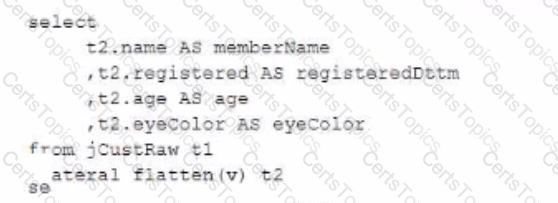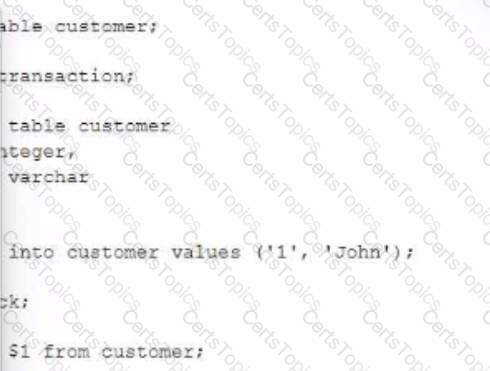The JSON below is stored in a variant column named v in a table named jCustRaw:

Which query will return one row per team member (stored in the teamMembers array) along all of the attributes of each team member?
A)

B)

C)

D)

Which output is provided by both theSYSTEM$CLUSTERING_DEPTHfunction and theSYSTEM$CLUSTERING_INFORMATIONfunction?
The following code is executed ina Snowflake environment with the default settings:

What will be the result of the select statement?
How can the following relational data be transformed into semi-structured data using the LEAST amount of operational overhead?

Assuming that the session parameter USE_CACHED_RESULT is set to false, what are characteristics of Snowflake virtual warehouses in terms of the use of Snowpark?
A new customer table is created by a data pipeline in a Snowflake schema where MANAGED ACCESSenabled.
…. Can gran access to the CUSTOMER table? (Select THREE.)
Within a Snowflake account permissions have been defined with custom roles and role hierarchies.
To set up column-level masking using a role in the hierarchy of the current user, what command would be used?
Which callback function is required within a JavaScript User-Defined Function (UDF) for it to execute successfully?
A Data Engineer has developed a dashboard that will issue the same SQL select clause to Snowflake every 12 hours.
---will Snowflake use the persisted query results from the result cache provided that the underlying data has not changed^
Which Snowflake objects does the Snowflake Kafka connector use? (Select THREE).
A CSV file around 1 TB in size is generated daily on an on-premise server A corresponding table. Internal stage, and file format have already been created in Snowflake to facilitate the data loading process
How can the process of bringing the CSV file into Snowflake be automated using the LEAST amount of operational overhead?
A Data Engineer has written a stored procedure that will run with caller's rights. The Engineer has granted ROLEA right to use this stored procedure.
What is a characteristic of the stored procedure being called using ROLEA?
A Data Engineer ran a stored procedure containing various transactions During the execution, the session abruptly disconnected preventing one transactionfrom committing or rolling hark.The transaction was left in a detached state and created a lock on resources
...must the Engineer take to immediately run a new transaction?
A company is using Snowpipe to bring in millions of rows every day of Change Data Capture (CDC) into a Snowflake staging table on a real-time basis The CDC needs to get processedand combined with other data in Snowflake and land in a final table as part of the full data pipeline.
How can a Data engineer MOST efficiently process the incoming CDC on an ongoing basis?
A Data Engineer is implementing a near real-time ingestionpipeline to toad data into Snowflake using the Snowflake Kafka connector. There will be three Kafka topics created.
……snowflake objects are created automatically when the Kafka connector starts? (Select THREE)
Which methods will trigger an action that will evaluate a DataFrame? (Select TWO)
A company has an extensive script in Scala that transforms data by leveraging DataFrames. A Data engineer needs to move these transformations to Snowpark.
…characteristics of data transformations in Snowpark should be considered to meet this requirement? (Select TWO)